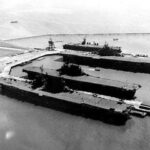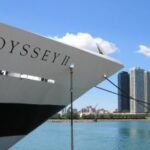Floating alongside Navy Pier in San Diego, the aircraft carrier U.S.S. Midway has begun a second life as a museum of naval aviation and history. The Midway herself was commissioned in September 1945 and served for nearly fifty years, being decommissioned in 1992. The museum intends to bring the naval history and Midway’s history for those five decades to life through exhibits, programs and a unique “oral history” project.
The carrier was moved to San Diego from its decommissioned home in Bremerton, Washington and was opened as the museum in 2004. Restoration of both the ship and over two dozen embarked aircraft continues with a goal of 31 aircraft of all types to be available for visitors. The ship also presents the changes in naval technology that occurred during its fifty years of service, radar, communications, combat control and flight ops.
When launched, CV-41, the Midway, was the largest carrier afloat. From its launch through the mid 1950’s, Midway served in the Atlantic and Mediterranean. In 1954 and 1955 Midway patrolled the Taiwan Strait while tensions between Communist China and free China were at a boiling point.
From 1955-1957 Midway underwent a refit that changed her flight deck to an angled one. This, with the addition of current flight ops gear, made Midway a combat force to be reckoned with.
Midway continued her patrols in the Pacific, and the aircraft she could carry were changed with with the addition of Mach 2.2 F-4B Phantom IIs.
In 1965 Midway took her first combat cruise, off the coast of Vietnam. Her nine month cruise earned her the Battle Efficiency “E” which marked her as the most outstanding carrier in the Pacific Fleet.
More refitting took place from 1966-1970. Changes included increasing the size of her flight deck and the capacity of her elevators. In 1971, she took another combat cruise off Vietnam, 146 days at sea.
Her rest was not to be. Conditions in Vietnam necessitated her next combat cruise, some seven weeks early, April 1972. She was at sea for 208 days and served on station until the signing of the ceasefire.
In September of 1973, the Midway carrier battle group became the first forward deployed group, Her new home port was Yokosuka, Japan.
In April 1975, with the armored assault from North Vietnam crushing the South, Midway moved to the coast of Vietnam again. Midway’s aircraft moved over 3,000 Americans and dependents from Saigon. In a historic moment, the South Vietnamese pilot of a light aircraft was able to locate Midway, the deck was cleared, and the pilot landed safely. He and his family now live in the United States.
Midway then moved into the Gulf of Siam and recovered over a hundred American aircraft, preventing their capture by the invading North Vietnamese. The ship then steamed to Guam where the aircraft were offloaded.
Through the next decade Midway patrolled the western Pacific and the Indian Ocean. In 1986 Midway received yet another overhaul, in Japan, and her aging aircraft load of Phantoms and Corsairs was replaced with F/A 18 Hornets.
In October 1990, with her decommissioning already announced, Midway was sent to the North Arabian Sea to support the buildup for Desert Storm. Her aircraft dropped over 4 million pounds of ordnance during 43 days of combat. She was the only carrier to suffer no combat losses and one of her embarked helicopter assets was responsible for the only Navy capture or liberation of property – an island, in the conflict.
A short time after her return to Japan, she was deployed to assist in the evacuation of Clark Air Base in the Philippines shortly before the violent eruption of the Mt. Pinatubo volcano in 1991. Over 1,800 were brought on board, including many pets.
She was decommissioned the following year.
The Midway Museum’s aircraft exhibits cover the entire history of the carrier. From the Dauntless and Avenger through the Corsair and Phantom to the Hornet and Tomcat, the aircraft that Midway sent into combat are present. Also available are a number of helicopters, a Hawkeye radar aircraft and a Viking submarine hunter. Still others, like a Grumman Wildcat, await funding for restoration.
The Museum is open 10 a.m. to 5 p.m. everyday but Thanksgiving and Christmas. Tickets range from $17 for adults to $13 for seniors and students, $10 for retired military with i.d. and $9 for children 6-17. Active duty military and children under 6 are free. Admission provides you with an audio tour of the ship, with each point narrated by a former seaman who served in that area. These oral recollections cover the entire history of the ship. Overnight programs are available.





